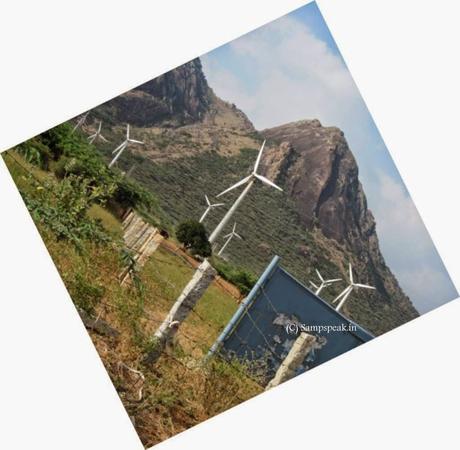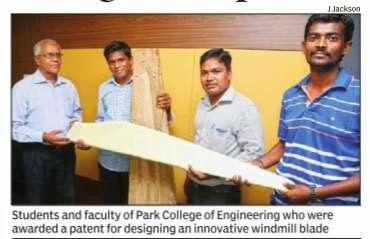 One
important component of WEG is its blades generally made of wood, canvass,
fibre. The blades have to be low weight or density to reduce gravitational
forces and have high strength to withstand strong loading of wind and
gravitational force of the blade itself; they also should withstand environmental impacts such as lightning
strikes, humidity, and temperature.
Wood and canvas
sails were used on early windmills due to their low price, availability, and
ease of manufacture. Smaller blades can be made from light metals such as
aluminium. These materials, however, require frequent maintenance. Wood and
canvas construction limits the airfoil shape to a flat plate, which has a
relatively high ratio of drag to force captured (low aerodynamic efficiency)
compared to solid airfoils. They have 2
portion – one attached to the hub otherwise nozzle, on the tower – at the other
end is the tip attached to the blade through a Carbon Axle Shaft fixed on a
Guide Tube through Guide Pin arrangement and Steel Wire which is actuated by a
Hydraulic cylinder mounted on the Blade.
The movement of the Tip during activation by Hydraulic Pressure (Axial
Displacement of 135 mm and 75 deg Rotation) is controlled by an S-shaped milled
Track in Tip Guide. The Tip moves
approximately 135 mm away from the Blade with the help of Carbon Shaft with Guided Track and Steel wire
fastened to Threaded Plug.
The blade is built
as self supporting structure comprising of two skin halves mounted around the
Main spar. The latter transforming from a Rootspar into Two Y-Spars extending
all the way to the Tip. Shells, Spars
and Root sections are made of Fibre glass reinforced Polyster where the main
strength properties are achieved by using continuous Fibres called
Unidirectional Rowings. The aerodynamic
tip brake is attached to blade portion through a carbon shaft through guide pin
arrangement and steel wire which is actuated by hydraulic cylinder.
The blades do get
damaged whilst in transit and while in operation causing loss of property as
also stoppage in production of wind power.
In a
recent post, Times of India reports that students and staff of Park College of
Engineering and Technology, Coimbatore have been awarded a patent by the Indian
Patent Office for designing a low-speed windmill blade. The design has the
potential to produce power at 3msec wind velocity and stands out from the ones
already available in the windmill industry.
A P
Haran, K Prasanna, P Mani Bharathi and Karthik V were awarded the patent last
week for designing the windmill blade. While Haran and Prasanna are faculty
members of the aeronautical engineering department, Mani Bharathi and Karthik
are alumni of the institution, who worked on the project for almost three
years. Mani Bharathi and Karthik, who
belong to the 2008-2012 batch of BE aeronautical engineering, were keen on
doing something in the field of renewable energy . “There were long power cuts
during the period, and everyone was looking for alternative sources for power.
Solar and wind energy started gaining importance at that time,“ said Karthik.
This was the motivation for the duo to suggest an idea to A P Haran, the dean
of mechanical sciences. The students along with Prasanna K, an assistant
professor with the aeronautical engineering department, studied some designs
made by Indian windmill companies, and some designs from China and Japan, too.
One
important component of WEG is its blades generally made of wood, canvass,
fibre. The blades have to be low weight or density to reduce gravitational
forces and have high strength to withstand strong loading of wind and
gravitational force of the blade itself; they also should withstand environmental impacts such as lightning
strikes, humidity, and temperature.
Wood and canvas
sails were used on early windmills due to their low price, availability, and
ease of manufacture. Smaller blades can be made from light metals such as
aluminium. These materials, however, require frequent maintenance. Wood and
canvas construction limits the airfoil shape to a flat plate, which has a
relatively high ratio of drag to force captured (low aerodynamic efficiency)
compared to solid airfoils. They have 2
portion – one attached to the hub otherwise nozzle, on the tower – at the other
end is the tip attached to the blade through a Carbon Axle Shaft fixed on a
Guide Tube through Guide Pin arrangement and Steel Wire which is actuated by a
Hydraulic cylinder mounted on the Blade.
The movement of the Tip during activation by Hydraulic Pressure (Axial
Displacement of 135 mm and 75 deg Rotation) is controlled by an S-shaped milled
Track in Tip Guide. The Tip moves
approximately 135 mm away from the Blade with the help of Carbon Shaft with Guided Track and Steel wire
fastened to Threaded Plug.
The blade is built
as self supporting structure comprising of two skin halves mounted around the
Main spar. The latter transforming from a Rootspar into Two Y-Spars extending
all the way to the Tip. Shells, Spars
and Root sections are made of Fibre glass reinforced Polyster where the main
strength properties are achieved by using continuous Fibres called
Unidirectional Rowings. The aerodynamic
tip brake is attached to blade portion through a carbon shaft through guide pin
arrangement and steel wire which is actuated by hydraulic cylinder.
The blades do get
damaged whilst in transit and while in operation causing loss of property as
also stoppage in production of wind power.
In a
recent post, Times of India reports that students and staff of Park College of
Engineering and Technology, Coimbatore have been awarded a patent by the Indian
Patent Office for designing a low-speed windmill blade. The design has the
potential to produce power at 3msec wind velocity and stands out from the ones
already available in the windmill industry.
A P
Haran, K Prasanna, P Mani Bharathi and Karthik V were awarded the patent last
week for designing the windmill blade. While Haran and Prasanna are faculty
members of the aeronautical engineering department, Mani Bharathi and Karthik
are alumni of the institution, who worked on the project for almost three
years. Mani Bharathi and Karthik, who
belong to the 2008-2012 batch of BE aeronautical engineering, were keen on
doing something in the field of renewable energy . “There were long power cuts
during the period, and everyone was looking for alternative sources for power.
Solar and wind energy started gaining importance at that time,“ said Karthik.
This was the motivation for the duo to suggest an idea to A P Haran, the dean
of mechanical sciences. The students along with Prasanna K, an assistant
professor with the aeronautical engineering department, studied some designs
made by Indian windmill companies, and some designs from China and Japan, too.
 “We
found that windmills had difficulty producing power at low wind velocity and
this was the challenge we took up for our design,“ said Bharathi. The team then
identified parameters like weight, material and aerodynamics of the blade. Dean
Haran said that they attempted to sell the blade design to some windmill
companies, but had a better offer waiting for them.
With regards – S.
Sampathkumar
“We
found that windmills had difficulty producing power at low wind velocity and
this was the challenge we took up for our design,“ said Bharathi. The team then
identified parameters like weight, material and aerodynamics of the blade. Dean
Haran said that they attempted to sell the blade design to some windmill
companies, but had a better offer waiting for them.
With regards – S.
Sampathkumar
30th Apr 2015.

